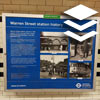Northern line history Find out more at
www.ltmuseum.co.uk The Northern line is a vital north-south artery that carries more customers than any other Underground line.
The first section of the line opened in 1890. when the City & South London Railway began running services between King William Street (near Bank) and Stockwell. It was the first deep tube line, as well as the first to be powered by electricity.
In 1907, the competing Charing Cross, Euston and Hampstead Railway, known colloquially as the Hampstead Tube, opened its own deep tube service from Charing Cross through Camden to Golders Green and Archway.
In the 1920s, following the merger of these companies, the separate Bank and Charing Cross branches were joined at Camden. The line was extended in the north to Edgware and in the south to Morden. Further expansion was planned in the 1930s. with a proposed extension to East Finchley, Bushey Heath and Alexandra Palace. This project was interrupted by the Second World War. In the post-war period, services to High Barnet were taken over by the line, but other services were not extended beyond Mill Hill East.
The new extension of the Northern line, running to Nine Elms and Battersea Power Station, will bring the Underground to another area of south London.
[Images]
1907: Tufnell Park was one of the original stations on the Hampstead Tube. It still features the oxblood faience tile exterior associated with its architect, Leslie Green
1926: This poster was used to publicise the extension to Morden, featuring clippings of newspaper articles about the extension
2013: Eric Aumonier’s artwork The Archer, at East Finchley station. is an unofficial symbol of the Northern line
2020: A worker installs a roundel at the new Battersea Power Station Underground station
© TFL courtesy of the London Transport Museum
MAYOR OF LONDON
Logo of the Underground
TRANSPORT FOR LONDON - EVERY JOURNEY MATTERS


 Click for a larger image
Click for a larger image  Click for a larger image
Click for a larger image  Click for all signs belonging to London Underground History
Click for all signs belonging to London Underground History
 780 Meter |
780 Meter |  838 Meter |
838 Meter |  841 Meter |
841 Meter |  1.17 Km |
1.17 Km |  1.47 Km
1.47 Km